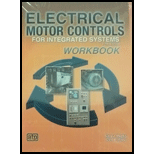Solutions for Electrical Motor Controls for Integrated Systems Workbook
Browse All Chapters of This Textbook
Chapter 1.1 - Electrical TheoryChapter 1.2 - CircuitsChapter 1.3 - MagnetismChapter 1.4 - PowerChapter 2.1 - Language Of ControlChapter 2.2 - Electrical CircuitsChapter 3.1 - SafetyChapter 3.2 - General Use Test InstrumentsChapter 3.3 - Specialty Test InstrumentsChapter 4.1 - Electrical Safety
Chapter 4.2 - Lockout/tagoutChapter 4.3 - Personal Protective EquipmentChapter 4.4 - Fire SafetyChapter 4.5 - Confined SpacesChapter 4.6 - Overhead Power Line SafetyChapter 5.1 - Basic Rules Of Line DiagramsChapter 5.2 - Line Diagrams-signals, Decisions, And ActionsChapter 5.3 - Logic FunctionsChapter 5.4 - Common Control CircuitsChapter 5.5 - Control Circuit TroubleshootingChapter 6.1 - Industrial PushbuttonsChapter 6.2 - Selector SwitchesChapter 6.3 - JoysticksChapter 6.4 - Limit SwitchsChapter 6.5 - Foot SwitchesChapter 6.6 - Pressure SwitchesChapter 6.7 - Temperature SwitchesChapter 6.8 - Flow SwitchesChapter 6.9 - Level SwitchesChapter 6.10 - Preventing Problems When Installing Control DevicesChapter 7.1 - ElectromagnetsChapter 7.2 - SolenoidsChapter 7.3 - Solenoid CharacteristicsChapter 7.4 - Solenoid ApplicationsChapter 7.5 - Troubleshooting SolenoidsChapter 8.1 - Electromechanical RelaysChapter 8.2 - Types Of Electromechanical RelaysChapter 8.3 - Troubleshooting Electromechanical RelaysChapter 9.1 - Dc Generator ComponentsChapter 9.2 - Dc Generator TypesChapter 10.1 - Ac Generator ComponentsChapter 10.2 - Ac Generator TypesChapter 10.3 - Voltage ChangesChapter 11.1 - TransformersChapter 11.2 - Transformer ConnectionsChapter 11.3 - Transformer SelectionChapter 11.4 - Troubleshooting TransformersChapter 12.1 - Manual SwitchingChapter 12.2 - Manual ContactorsChapter 12.3 - Manual StartersChapter 12.4 - Magnetic ContactorsChapter 12.5 - Magnetic Motor StartersChapter 12.6 - Contactor And Magnetic Motor Starter ModificationsChapter 12.7 - Troubleshooting Contactors And Motor StartersChapter 13.1 - Dc Motor OperationChapter 13.2 - Dc Motor ConstructionChapter 13.3 - Dc Motor TypesChapter 13.4 - Stepper MotorsChapter 13.5 - Dc Motor Load RequirementsChapter 13.6 - Troubleshooting Dc MotorsChapter 14.1 - Ac Motor TypesChapter 14.2 - Ac Motor MaintenanceChapter 14.3 - Troubleshooting Ac MotorsChapter 15.1 - Reversing Motors Using Manual StartersChapter 15.2 - Reversing Motors Using Drum SwitchesChapter 15.3 - Reversing Motors Using Magnetic SwitchesChapter 15.4 - Magnetic Reversing Starter ApplicationsChapter 15.5 - Motor Control Wiring MethodsChapter 15.6 - Troubleshooting Reversing Power CircuitsChapter 16.1 - TimersChapter 16.2 - Timing FunctionsChapter 16.3 - Multiple-contact TimersChapter 16.4 - Troubleshooting Contact-based Timing CircuitsChapter 16.5 - Counters And TotalizersChapter 17.1 - Friction BrakesChapter 17.2 - PluggingChapter 17.3 - Electric BrakingChapter 17.4 - Dynamic BrakingChapter 18.1 - Understanding Motor Loads And Torque RequirementsChapter 18.2 - Power QualityChapter 18.3 - Motor LoadsChapter 18.4 - Motor Torque TypesChapter 18.5 - Open And Closed Circuit TransitionChapter 19.1 - Reduced-voltage StartingChapter 19.2 - Dc Motor Reduced-votlage StartingChapter 19.3 - Reduced-voltage Starting For Three-phase Induction MotorsChapter 19.4 - Primary Resistor StartingChapter 19.5 - Autotransformer StartingChapter 19.6 - Part-winding StartingChapter 19.7 - Wye-delta StartingChapter 19.8 - Starting Method ComparisonChapter 19.9 - Troubleshooting Reduced-voltage Starting CircuitsChapter 20.1 - RectifiersChapter 20.2 - Dc Power Supply FiltersChapter 20.3 - Voltage RegulatorsChapter 20.4 - Fuel CellsChapter 20.5 - Photovoltaic CellsChapter 20.6 - Troubleshooting Dc Power SuppliesChapter 21.1 - ThermistorsChapter 21.2 - Photoconductive CellsChapter 21.3 - Photoconductive DiodesChapter 21.4 - Pressure SensorsChapter 21.5 - Flow Detection SensorsChapter 21.6 - Hall Effect SensorsChapter 21.7 - Proximity SensorsChapter 21.8 - Ultrasonic SensorsChapter 22.1 - AmplificationChapter 22.2 - Operational AmplifiersChapter 22.3 - Field-effect TransisotrsChapter 22.4 - Troubleshooting Insulated Gate Bipolar TransistorsChapter 23.1 - Solid-state SwitchesChapter 23.2 - Silicon-controlled RectifiersChapter 23.3 - TriacsChapter 23.4 - DiacsChapter 23.5 - Unijunction TransistorsChapter 24.1 - Photoelectric DevicesChapter 24.2 - Photoelectric SensorsChapter 24.3 - Fiber OpticsChapter 24.4 - Photoelectric Sensor ApplicationsChapter 24.5 - Photoelectric Control ApplicationsChapter 25.1 - Solid-state RelaysChapter 25.2 - Electromechanical And Solid-state Relay ComparisonChapter 25.3 - Troubleshooting Solid-state RelaysChapter 25.4 - Solid-state Motor StartersChapter 26.1 - Motor DrivesChapter 26.2 - Programming Motor DrivesChapter 26.3 - Dc Motor DrivesChapter 26.4 - Ac Motor DrivesChapter 26.5 - Troubleshooting Motor Drive CircuitsChapter 27.1 - Programmable ControllersChapter 27.2 - Programmable Controller SectionsChapter 27.3 - Programmable Controller ApplicationsChapter 27.4 - Troubleshooting Programmable ControllersChapter 28.1 - Electrical Power DistributionChapter 28.2 - Distribution TransformersChapter 28.3 - Power Quality ProblemsChapter 28.4 - Smart GridsChapter 29.1 - Preventive Maintenance PrinciplesChapter 29.2 - AlignmentChapter 29.3 - BearingsChapter 29.4 - Flexible Belt DrivesChapter 29.5 - Prventive Maintenance TestsChapter 30.1 - Predictive Maintenance MonitoringChapter 30.2 - Maintenance Technicial Resources
More Editions of This Book
Corresponding editions of this textbook are also available below:
Electrical Motor Controls for Integrated Systems
5th Edition
ISBN: 9780826912268
EBK ELECTRICAL MOTOR CONTROLS FOR INTEG
5th Edition
ISBN: 8220101434760
ELECTRICAL MOTOR CONTROLS F/INT..-TEXT
5th Edition
ISBN: 2810015115471
Electrical Motor Controls For Integrated Systems: Applications Manual
5th Edition
ISBN: 9780826912299
Electrical Motor Controls for Integrated Systems Applications Manual
4th Edition
ISBN: 9780826912206
ELECTRICAL MOTOR CONTROLS
4th Edition
ISBN: 9780826916716
Related Electrical Engineering Textbooks with Solutions
Still sussing out bartleby
Check out a sample textbook solution.
